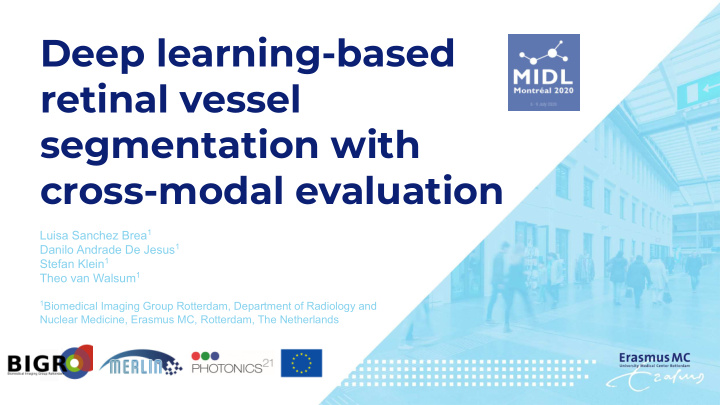



Deep learning-based retinal vessel segmentation with cross-modal evaluation Luisa Sanchez Brea 1 Danilo Andrade De Jesus 1 Stefan Klein 1 Theo van Walsum 1 1 Biomedical Imaging Group Rotterdam, Department of Radiology and Nuclear Medicine, Erasmus MC, Rotterdam, The Netherlands
Clinical context Why is it relevant to segment the retinal vessel tree? Fundus Scanning laser photography (FP) ophthalmoscopy (SLO) Pathologies: hypertensive retinopathy, diabetic retinopathy Biomarkers: vascular wall changes, arteriolar constriction, arterio venous nicking, changes in tortuosity Assist the clinician providing automatic , quantitative , and repeatable measurements
State of the art Fundus photography is older, larger Scanning laser opthtalmoscopy is less datasets and more annotations available used, not many annotated datasets Several approaches proposed on fundus Barely any work on vessel segmentation in photography vessel segmentation scanning laser ophthalmoscopy Variety of techniques, both Wide variety of architectures specific and general-purpose and parameters makes networks comparison difficult
State of the art Scanning laser ophthalmoscopy is becoming increasingly common Fundus photography is older, larger Scanning laser opthtalmoscopy is less datasets and more annotations available used, not many annotated datasets Scanning laser ophthalmoscopy image quality is higher for some pathologies Several approaches proposed on fundus Barely any work on vessel segmentation in photography vessel segmentation scanning laser ophthalmoscopy Variety of techniques, both Wide variety of architectures specific and general-purpose and parameters makes networks comparison difficult
Motivation Fundus photography is older, larger Scanning laser opthtalmoscopy is less datasets and more annotations available used, not many annotated datasets Several approaches proposed on fundus Barely any work on vessel segmentation in photography vessel segmentation scanning laser ophthalmoscopy Goal: propose guidelines on parameters Define architecture based on literature and architectures for vessel segmentation review Variety of techniques, both Wide variety of architectures specific and general-purpose and parameters makes networks comparison difficult
Motivation Fundus photography is older, larger Scanning laser opthtalmoscopy is less datasets and more annotations available used, not many annotated datasets Several approaches proposed on fundus Barely any work on vessel segmentation in photography vessel segmentation scanning laser ophthalmoscopy Goal: propose guidelines on parameters Define architecture based on literature and architectures for vessel segmentation review Variety of techniques, both Wide variety of architectures specific and general-purpose and parameters makes networks comparison difficult Goal: study if training on one modality is Evaluate the model trained on one transferrable to the other modality using the other modality
Methods 32x32 N = 1 SLO 64x64 public DB N = 10 128x128 RCSLO N = 20 256x256 Amount Size IOSTAR Sample FP patches public DB U-Net Train DRIVE Train FP STARE Test FP Accuracy Train SLO CHASE Test SLO Sensitivity DB1 Evaluate Train FP Specificity HRF Test SLO Dice score Train SLO Available ground truth Test FP
Results Fundus photography Scanning laser ophthalmoscopy Original image Ground truth Model output
Results Average of inter-rater agreement
Results Larger patch sizes work better! Sensitivity and Dice are the most affected parameters
Results Between x10 and x20 there is no difference in some datasets Sensitivity and Dice are the most affected parameters
Results Tests using N = x20 Fundus photography knowledge is transferrable to scanning laser opthalmoscopy Scanning laser ophthalmoscopy knowledge is not transferrable to fundus photography
Conclusions A state-of-art CNN is able to obtain results comparable to previous approaches from the literature Sensitivity , specificity , and accuracy ~90% for all but one of the individual datasets A model trained on fundus photography is able to A model trained on scanning laser segment scanning laser ophthalmoscopy ophthalmoscopy has a significant drop in sensitivity when segmenting fundus photography accurately Sensitivity , specificity , and accuracy ~90% for the Sensitivity below 50% for the model trained on scanning laser ophthalmoscopy tested on fundus model trained on fundus photography and tested on photography scanning laser opthtalmoscopy
Thank you! m.sanchezbrea@erasmusmc.nl
Recommend
More recommend